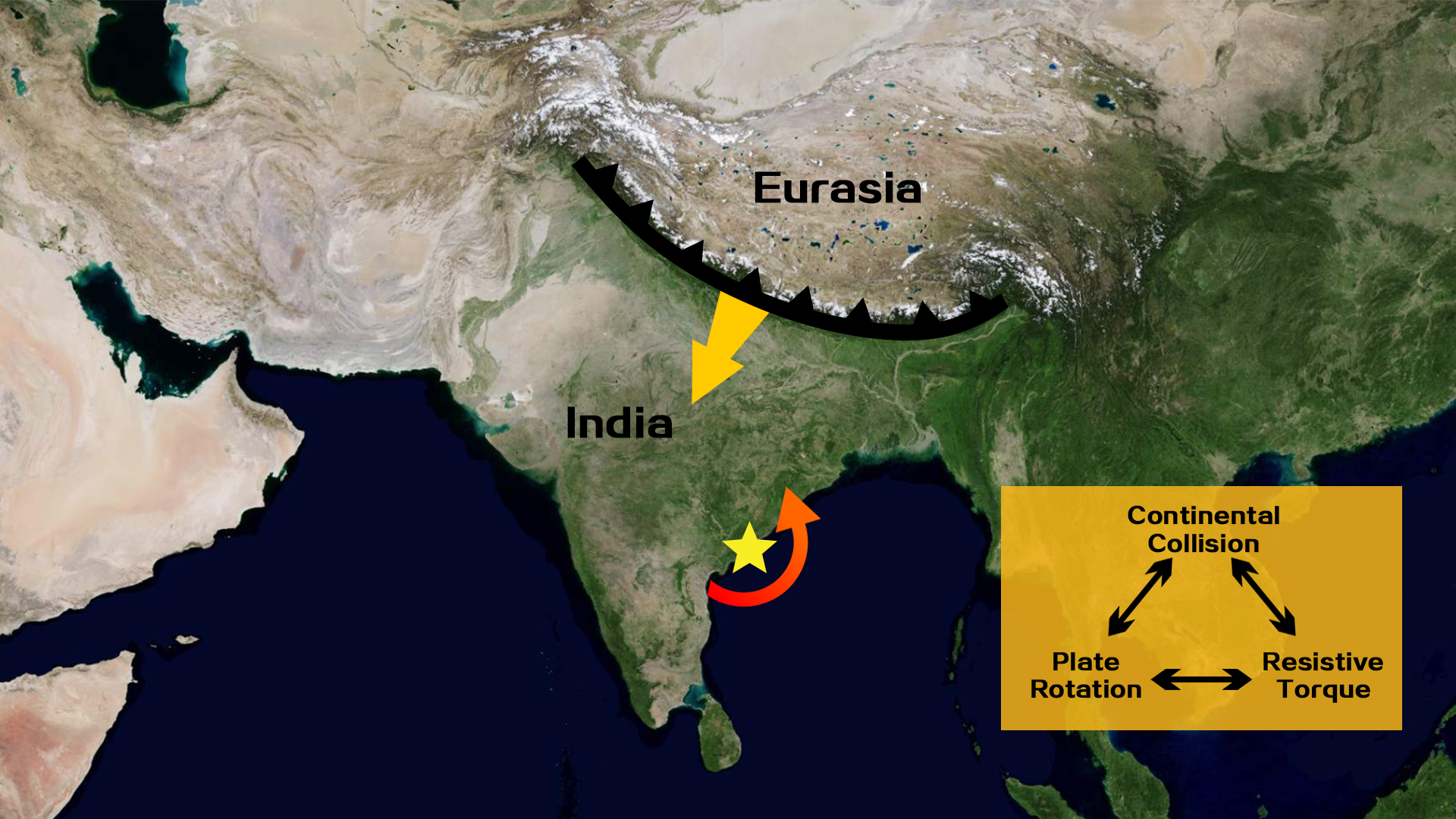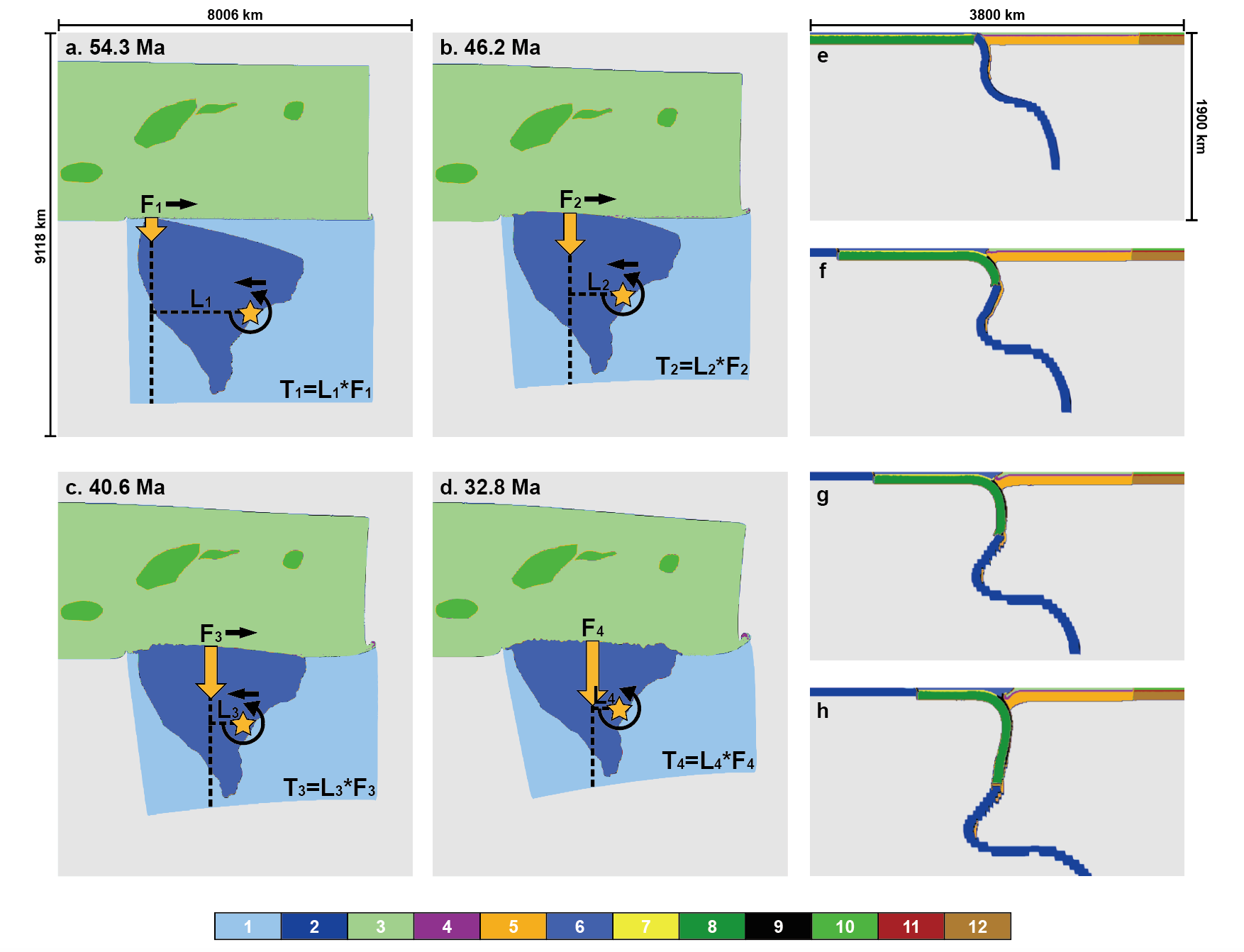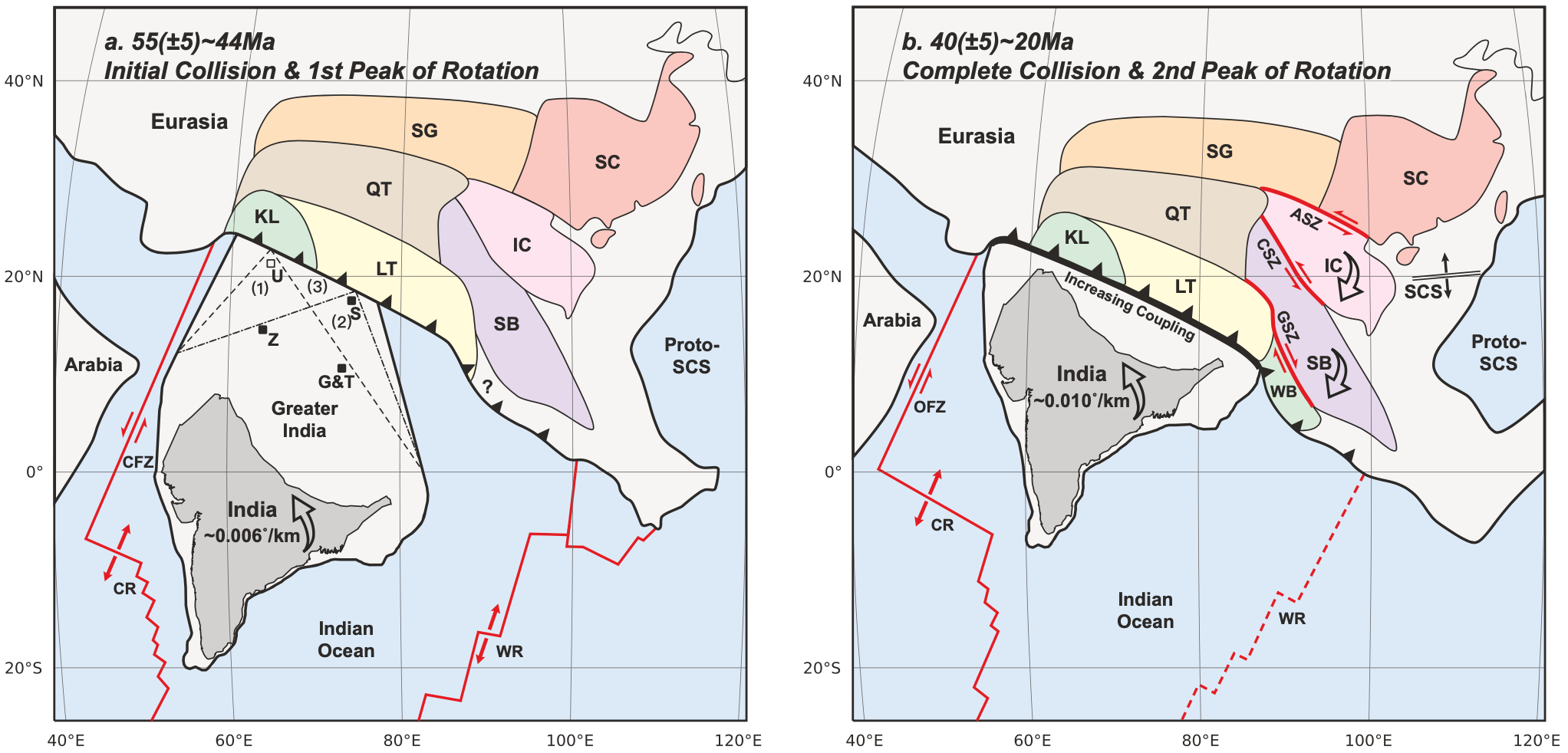The Tibetan Plateau was formed by the collage of multiple terranes that continuously collided with Eurasia, and the most recent event was the collage of India. Accurate reconstruction of the collision process between India and Eurasia is the key to understanding the Tibetan Plateau’s tectonic evolution.
In the past half-century, a series of geological evidence reflecting the initial collision has been obtained along the Yarlung Zangbo suture zone, including provenance changes, ultra-high pressure metamorphism, and paleolatitude overlap. However, there are great differences in the time of initial collision constrained by indicators at different locations. One possible explanation is the diachronous collision. By comparing the geological evidence along the suture zone, different diachronous collision processes have been proposed, including the initial collision in the western, middle, or eastern side of the northern margin of the Indian continent. Also, some researchers believe that India collided with Eurasia without diachroneity. Due to the discontinuous distribution of geological evidence along the suture and the large difference in their characteristics, it is difficult to obtain the collision process by directly comparing the timing of collision at different locations.

Associate Professor Jiashun Hu’s research group from the Department of Earth and Space Sciences at the Southern University of Science and Technology (SUSTech) has recently made new progress in the study of constraining the India-Eurasia collision process using plate rotation records.
The research work, entitled “Paleogene India-Eurasia collision constrained by observed plate rotation”, has been published in the international academic journal Nature Communications.
The kinematic information of the Indian plate recorded by the oceanic magnetic anomaly provides a new constraint for understanding the collision process between India and Eurasia. Previous studies have reconstructed the trajectory and velocity variation of a single reference point on the Indian plate. The drifting speed of the Indian continent decreased sharply at around 50 Ma (Figure 1), which is generally considered to be a direct response to the massive resistive force induced by continental collision. Resistive force can not only reduce the speed of drifting but also generate significant torque, which can significantly change the rotational motion of the Indian plate. Theoretically, different collision processes proposed by previous studies should correspond to different changes in the lever arms and torques. Therefore, the rotation motion of the Indian plate records key information about the collision process between India and Eurasia.
Based on the above ideas, the research group extracted the Cenozoic rotation information of the Indian plate and performed systematic numerical modeling, which quantitatively constrained the collision process between India and Eurasia in the Paleogene. Based on the latest global plate reconstructions, they first reconstructed the trajectories of the two northern and southern reference points on the Indian plate. The azimuth variations of their connections reflect the rotation motion of the Indian plate (Figure 1). There are two counterclockwise rotation rate peaks for the Indian plate during the Cenozoic. The earlier one is between 52-44 Ma with a rotation rate of about 0.006°/km, which is accompanied by the significant deceleration of the Indian continent. The latter was between 33-20 Ma with a rotation rate of about 0.010°/km, during which the Indian continent drifted at a similar rate to that of today. The rotation rate of both peaks is significantly higher than the background average of 0.003°/km.

Figure 1. Cenozoic motion of the Indian plate. (a) Reconstruction of reference points. (b) Variations of the azimuth over time. (c) Velocity (dashed line) and rate of rotation (solid line).
Subsequently, the researchers carried out a series of three-dimensional, fully dynamic numerical modeling experiments. They designed three sets of models based on the previously proposed collision models, including the west bulging, the middle bulging, and the eastern bulging of the northern margin of the Indian continent. As the model evolves, the Indian plate continues to move towards the Eurasian plate under the pull of the subducting slab, accompanied by a significant counterclockwise rotation (Figure 2). For the west and middle bulging models, two counterclockwise rotation peaks can be observed, which is in great consistency with observations (Figure 3). In both models, the initial and complete collision between India and Eurasia is 5-10 Myrs earlier than the rotation peaks, and the time discrepancy depends on the evolution of the resistive torques.
The geometric center of the Indian plate is taken as the center of mass. For the initial collision, when the Indian and the Eurasian continental crust initially contact, the resistive forces and torques are not significant, so there is no obvious extra rotation. With the continuous expansion of collision, the resistive forces and torques increase significantly, forming the first rotation rate peak. When it further develops into a complete collision, the effect of the shortening of the lever arm becomes gradually significant; the torques decrease, accompanied by the deceleration of the rotation rate (Figure 3).
The above qualitative analysis can be verified by the quantitative torque calculations. After the complete collision, with the continuous scrap of the Indian upper crust and the deformation of the overriding plate, the coupling between the plates gradually strengthened. The resistive forces and torques increase, forming the second rotation peak. The east bulging model cannot generate the first peak and fits the reconstruction the worst. This is because the initial collision occurs on the eastern side of the center of mass. As the collision goes on, the lever arm and torques gradually decrease to zero; thus no extra rotation can be generated (Figure 3).

Figure 2. Key snapshots of the evolution of the west-bulging model from (a-d) map view and (e-h) cross-sections. The orange stars represent the center of mass of the Indian plate. The orange arrows represent the resultant resistive force, with their lengths indicating force magnitudes. The horizontal dotted lines are lever arms of the torque.

Figure 3. Comparison of observed and modeled rates of rotation (a) and the evolution processes of the three models (b-d).
Based on the observed and modeled rotation motions of the Indian plate, Prof. Hu’s group proposed that the western-central side of the northern margin of India initially collided with Eurasia at 55±5 Ma, followed by a diachronous collision to the east, and a complete collision with Eurasia at 40±5 Ma (Figure 4). This inference is supported by a series of key geological evidence along the suture. In addition, the rotation peak at 33-20 Ma is thought to correspond to the enhanced coupling between the plates after the complete collision. This is consistent with the timing of the extrusion of several blocks in the southeast margin of the Tibetan Plateau. Seafloor spreading in the South China Sea also occurred at a similar time. Strong plate rotation and intensive intra-continental tectonic deformation may both indicate the strong coupling between the Indian and Eurasian plates during this time period (Figure 4).

Figure 4. Schematics showing the India-Eurasia collision process. (a) Initial collision and the first peak of rotation, and (b) Complete collision and the second peak of rotation.
Xiaoyue Wu, a visiting Ph.D. student in Assoc. Prof. Jiashun Hu’s research group, is the first author of this paper. Assoc. Prof. Jiashun Hu and Prof. Lijun Liu from the Institute of Geology and Geophysics, Chinese Academy of Sciences (IGGCAS) are the corresponding authors. The co-authors include Prof. Ling Chen from IGGCAS and Assoc. Prof. Liang Liu from the Guangzhou Institute of Geochemistry, Chinese Academy of Sciences (GIGCAS).
This research was supported by the National Natural Science Foundation of China and the Strategic Pilot Project (A) of the Chinese Academy of Sciences.
Paper link: https://www.nature.com/articles/s41467-023-42920-0
To read all stories about SUSTech science, subscribe to the monthly SUSTech Newsletter.
Proofread ByAdrian Cremin, Yingying XIA
Photo By